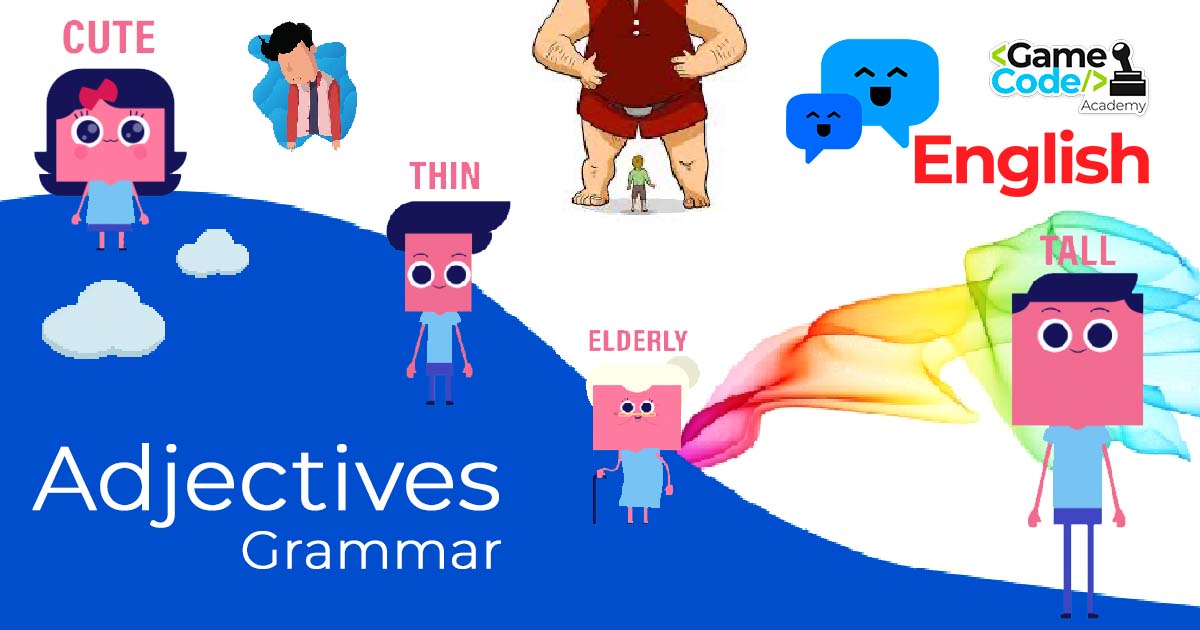
The adjectives in English Grammar – Summary
1. What are adjectives?
Adjectives tell us something about a person or a thing.
2. What do adjectives modify?
Adjectives tell us something about a person or Adjectives can modify nouns or pronouns/names.
| person | thing |
|---|---|
| Mandy is a careful girl . | This is a nice car. |
| Mandy is carefu. | The car is nice. |
| She is careful. | It is nice. |
3. Where do adjectives go?
An adjective can be put before the noun. Then it is an attribute.
| person | thing |
|---|---|
| Mandy is a careful girl. | This is a nice car. |
An adjective can be put after the verb to be (is). This is called predicative position.
| person | thing |
|---|---|
| The girl is careful. | This car is nice. |
Adjectives can go after the following verbs:
| be | seem | appear | look | sound |
| smell | taste | become | feel | get |
| go | keep | turn |
When we speak about what something looks like, smells, sounds and tastes – we use the adjective. Mind the difference between adjective and adverb.
I feel great.
She looks good.
It seems impossible.
The steak smells fantastic.
4. Can adjectives be used without nouns?
Yes, adjectives can be used without nouns.
Mind the definite article the:
the rich = rich
people
Here is an example from the fairy tale Cinderella:
- “The good must be put in the dish, the bad
you
may eat if you wish.”
Here is another example with nationalities in the plural:
- The Scottish live in the North of the United
Kingdom.
5. Can two or more adjectives be used together?
Yes, if you use more adjectives you can put them in front of the noun:
a fat old cat
or you can put them after the verb (e.g. to be). In this case and is placed between the last two
adjectives.
It was cold, wet and windy.
6. Adjectives, ending in -ing and -ed
There are adjectives ending in -ing and -ed. These are participle constructions, used like adjectives. Here are some examples:
A) Here the adjective is put before the noun:
Yesterday I read an amusing story in
a magazine.
Doris has a boring job.
We watched the group of excited
people.
B) Here the adjective is put after the verb:
I was not at all amused by the discussion.
Children get bored very quickly.
The end of the film was really exciting for me.
Comparison of adjectives
Grammatical constructions used for comparing adjectives
There are three forms of comparison:
- positive
- comparative
- superlative
1. Comparison with -er/-est
clean → cleaner → (the) cleanest We use -er/-est with the following adjectives:
1.1. Adjectives with one syllable
| positive | comparative | superlative |
|---|---|---|
| clean | cleaner | cleanest |
| new | newer | newest |
| cheap | cheaper | cheapest |
1.2. Adjectives with two syllables and the following endings:
1.2.1. Adjectives with two syllables, ending in -y
| positive | comparative | superlative |
|---|---|---|
| dirty | dirtier | dirtiest |
| easy | easier | easiest |
| happy | happier | happiest |
| pretty | prettier | prettiest |
1.2.2. Adjectives with two syllables, ending in -er
| positive | comparative | superlative |
|---|---|---|
| clever | cleverer | cleverest |
1.2.3. Adjectives with two syllables, ending in -le
| positive | comparative | superlative |
|---|---|---|
| simple | simpler | simplest |
1.2.4. Adjectives with two syllables, ending in -ow
| positive | comparative | superlative |
|---|---|---|
| narrow | narrower | narrowest |
1.3. Spelling of the adjectives using the endings -er/-est
| positive | comparative | superlative | comment |
|---|---|---|---|
| large | larger | largest | leave out the silent -e |
| big | bigger | biggest | Double the consonant after short vowel |
| sad | sadder | saddest | Double the consonant after short vowel |
| dirty | dirtier | dirtiest | Change -y to -i (consonant before -y) |
| shy | shyer | shyest | Here -y is not changed to -i. (although consonant before -y) |
2. Comparison with more – most
all adjectives with more than one syllable (except some adjectives with two syllables – see 2.1. to 2.4.)
| positive | comparative | superlative |
|---|---|---|
| difficult | more difficult | (the) most difficult |
3. Irregular adjectives
| positive | comparative | superlative | comment |
|---|---|---|---|
| good | better | best | |
| bad | worse | worst | |
| much | more | most | uncountable nouns |
| many | more | most | countable nouns |
| little | less | least | |
| little | smaller | smallest |
4. Special adjectives
Some adjectives have two possible forms of comparison (-er/est and more/most).
| positive | comparative | superlative |
|---|---|---|
| clever | cleverer / more clever | cleverest / most clever |
| common | commoner / more common | commonest / most common |
| likely | likelier / more likely | likeliest / most likely |
| pleasant | pleasanter / more pleasant | pleasantest / most pleasant |
| polite | politer / more polite | politest / most polite |
| quiet | quieter / more quiet | quietest / most quiet |
| simple | simpler / more simple | simplest / most simple |
| stupid | stupider / more stupid | stupidest / most stupid |
| subtle | subtler / more subtle | subtlest / most subtle |
| sure | surer / more sure | surest / most sure |
5. Difference in meaning with adjectives
| positive | comparative | superlative | comment |
|---|---|---|---|
| far | farther | farthest | distance |
| further | furthest | distance or time | |
| late | later | latest | |
| latter | X | ||
| X | last | ||
| old | elder | eldest | people (family) |
| nearer | nearest | distance | |
| X | next | order |
Order of adjectives in English Grammar
What is the general order of adjectives before a noun?
Sometimes we use more than one adjective (or noun used as an adjective) before a noun. If we don´t want to emphasise any one of the adjectives, the order is:
| opinion | size | age | shape | |
|---|---|---|---|---|
| a | wonderful | |||
| an | old | |||
| a | big | |||
| an | antique | |||
| a | lovely | |||
| a | small | around | ||
| a | huge | rectangular | ||
| a | new | |||
| a | young |
Note: Not everyone agrees on this order. Opinions differ on
age and shape.
We do not normally use more than three adjectives before a noun.
Sentences with comparisons in English
1. something is similar A=B
Our car is as fast as Peter's car.
2. Something is not similar A≠B
2.1. Use not as ... as (to say that something is not similar)
John's car is not as fast as our car. (A≠B)
2.2. Use than (to say that something is bigger or smaller)
Our car is faster than John's car. (A > B)
John's car is slower than our car. (A < B)
NOTE!
* Peter is taller than me.
* Peter is taller than I am. (formal)
* Max is as tall as me. (informal)
* Max is as tall as I am. (formal)
Do not mix up than with then. see: then or than –
Confusing words
Adverbs and adjectives that have the same form
Are there adjectives and adverbs that look the same?
Some adjectives and adverbs have the same form i.e. a fast car goes fast. The following adjectives and adverbs have the same form.
| Adjective | Adverb |
|---|---|
| close | close |
| daily | daily |
| early | early |
| fair | fair |
| far | far |
| fast | fast |
| free | free |
| hard | hard |
| high | high |
| late | late |
| like | like |
| lilkely | lilkely |
| live | live |
| long | long |
| low | low |
| right | right |
| wide | wide |
| wrong | wrong |
Tests
